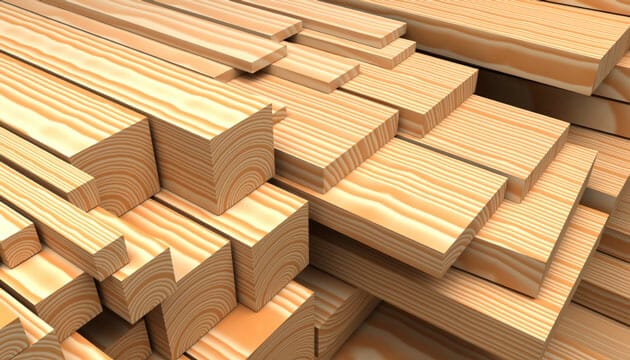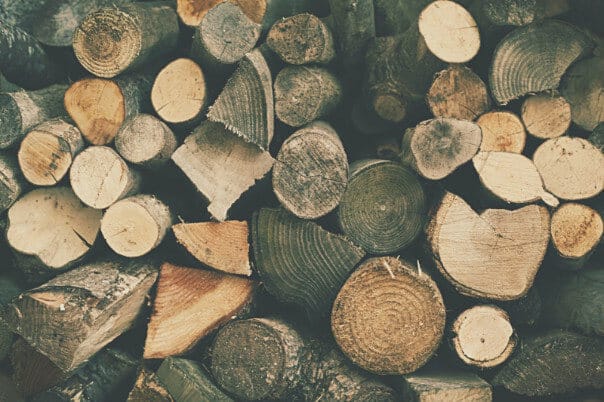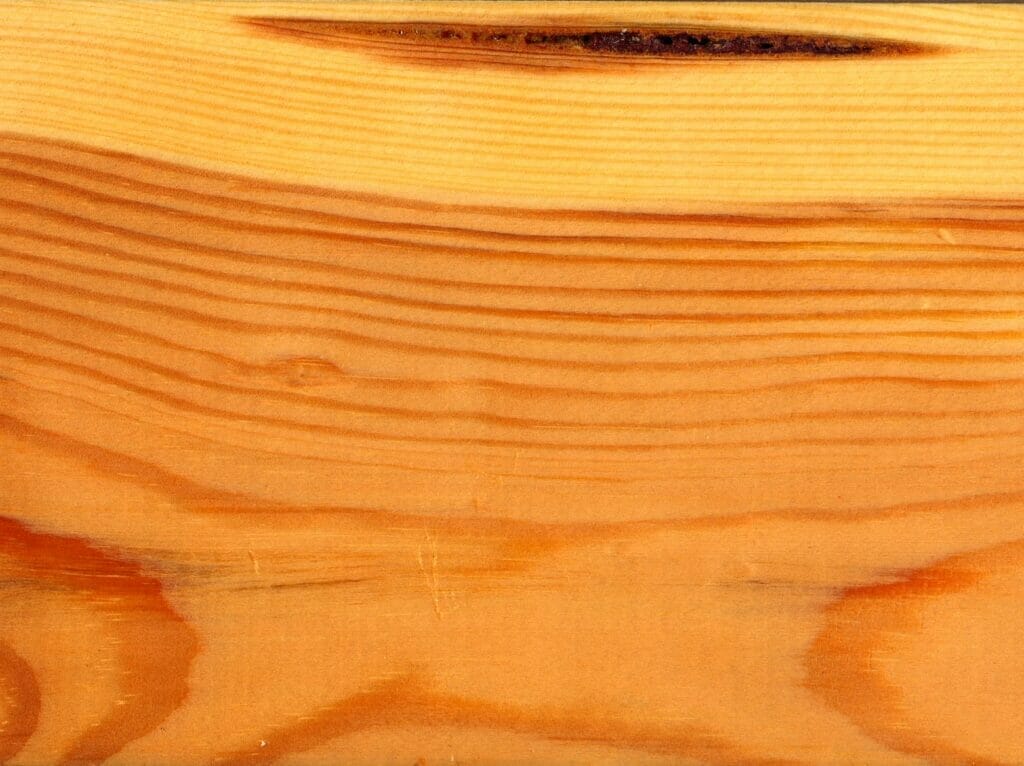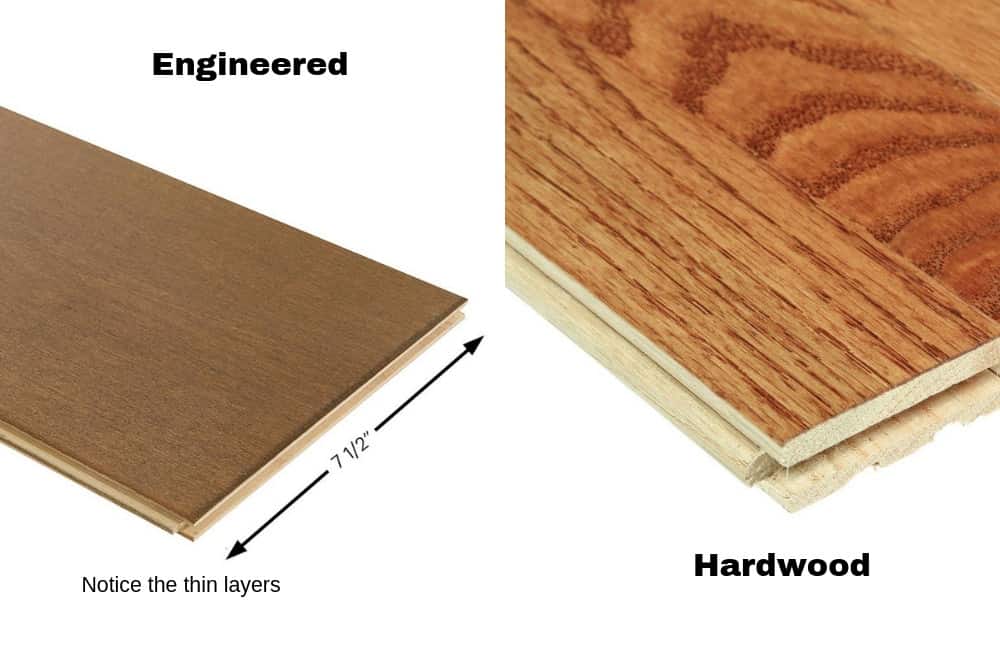Our Ultimate Guide To Different Wood Types & Usage

If your tackling a new DIY project, learning about the different types of wood and how they can be used is essential for getting the best result in your work.
This is because various types of wood have different properties, some being stronger for heavy-duty construction while others being better for delicate woodworking due to their finish.
To help you out with understanding how wood differs, we’ve put together an extensive guide below which will cover the main types of wood, different species of wood and their uses.
So without further chat, let’s get into it!
The Three Main Types Of Wood
Before we can get into our list of different woods and how you can use them, let’s discuss the three main types of wood so that you can decide what you need in your DIY work.
Hardwood
Hardwoods are typically made from trees that have leaves or seeds, this tree species is called deciduous trees, they do not come from tree species that have pine cones or needles.
Despite having hard in their name, this type of wood is not much stronger than softwood but is the ideal choice if you are looking for straight grain. Bamboo and palm are not deciduous trees but can be considered hardwood too.
Some common species of wood that fall under this category are oak wood types, maple, cherry, walnut and mahogany. You find hardwood in work such as tabletops due to their appearance.
Softwood
This type of wood comes from coniferous trees, this conifer trees produce needles and pine cones. Although this type of wood is known as ‘softwood’ this doesn’t mean that softwood is any softer than hardwood.
Softwood is an excellent choice for avoiding common problems with wood such as rotting making it perfect for outdoor furniture or framing construction work. A few basic varieties of softwood to name are; pine, cedar, fir, spruce and redwood.
Engineered Wood
Engineered woods are alternative woods that are man-made and do not originate naturally from trees like softwood and hardwood.
This type of wood has chemical properties and goes through heat treatment to achieve sizes and appearance not manageable with natural wood. Another name for these varieties of wood is composite wood.
Some popular types of engineered wood are; composite board, wood veneers, medium density fibreboard, plywood and oriented strand board. Most of these woods are used for interior decor projects and are often recycled from the waste of sawmills.
The Different Types Of Wood & How To Use Them In Construction

Now we know the main three types of wood and some examples, let’s get into detail about the different varieties of wood you can find according to name and their specific uses so as you can find the right type of wood you need for your construction work.
We’ve grouped all the types of wood into hardwood, softwood and engineered wood below to make it easier to find what you looking for.
Types Of Hardwood & Uses

Aspen
Alder
Alder is a common kind of wood nowadays due to its beautiful grained wood pattern, Alder wood is often found in the Northwest of California and Southwest of Canada.
Similar to a birch tree, Alderwood has a medium-density and appears white when first cut, the straight grain of this type of wood makes it a popular choice for carving, turning and finishing applications. It’s also a good choice for furniture making and can be stained or painted easily thanks to the flat surface.
An example of usage for Alder wood is in the construction of guitars thanks to its smooth appearance and grain, the wood also becomes a brown tone when exposed to sunlight. One drawback of this hardwood is that it can become expensive if you need to buy the wood in larger pieces.
We’ve summarised the points of Alder hardwood below.
- Straight grain and smooth surface.
- Brown in colour.
- Use in musical instruments, furniture and photo frames.
- Found in Northwest of California and Southwest of Canada.
- Expensive in large amounts.
Balsa
Balsa wood is a light hardwood and has a history of use during the war, this wood is used before the age of 10 years and is typically found in Central America. It is a low-density wood and is not regarded as very strong so should not be used in heavy-duty projects, its smooth surface is good for staining and painting, however.
When constructing with this wood you should be careful not to snap it and stick to using wood glue rather than nails.
Balsa wood is typically used in child woodworking projects but can also be used in building rafts too since its lightweight floats well. We would not recommend using this wood in projects which need a lot of strength, they are great in projects however that need to be taken down quickly such as movie sets.
- Not a strong wood.
- Good for light work and painting.
- Should never be used with nails.
- Great for use in projects such as movie sets.
Bamboo
Bamboo is typically not classed as hardwood but due to its hardness and high density, the plant can be used for a variety of building projects. Bamboo is very tough and resistant with its wax coating helping it stay resistant to outdoor weather and insects.
This exotic wood can also be sanded for painting and staining but should be sealed after for long term durability, bamboo stems can swell if used in a different climate, let the plant acclimatise before cutting to avoid this.
The main uses of bamboo are in garden furniture, flooring and cabinets, they can also be used as veneers when to cut into thin strips too and made into engineered wood such as plywood.
- Tough and resistant.
- Not a hardwood but classed as strong.
- Can be sanded for painting.
- Excellent for use in garden furniture.
- Veneer strips can be used in plywood.
Basswood
Basswood is a type of hardwood that has an attractive finish due to its straight and tight grain, it’s also easy to work within the application of construction and does not warp or flex.
This wood choice tends to be an economical choice too for construction material as the availability of wood is high. The only disadvantage of this wood is that it can’t be stained or painted easily so you would have to let the attractive wood grain show through.
In terms of usage, Basswood has no aromatic properties making it a popular choice for using in kitchen utensils or the construction of kitchen cabinets. It can also be used in building models thanks to the fact it has a smooth finish and is easy to work with.
- Beautiful finish.
- Hard to stain.
- Easy to work with and buy.
- No aromatic properties.
- Perfect for use in general woodwork and kitchen utensils.
Beech
Beechwood is a cream-toned type of wood with a straight grain type, the wood is sturdy and can be bent with ease making it good for furniture use. The wood is also low priced and easy to find, it can be stained easily and is simple to work with.
Due to the nice grain, Beechwood is often used in decor furniture and even in musical instruments such as piano casing. One drawback of this hardwood is that it does have the potential to shrink if in high humidity.
- A popular choice for furniture.
- Low priced.
- Easy to work with.
- Can shrink in high humidity.
Birch
Birchwood is a very strong kind of wood and can be used for application in construction and is a cheaper alternative to Oak. The wood cannot be painted or stained easily however and can appear blotchy in colour.
You can find Birch pretty much anywhere such as your local lumber store or garden centre.
- Very strong.
- Cheaper alternative to Oak.
- Hard to stain.
- Economical.
Cherrywood
Cherry wood starts with a light colour of pink which deepens to a red-brown over time, the wood can be stained too, however, but you should ensure all pieces match due to uneven blotchy patterns.
This cherrywood can be used in furniture making due to its beautiful colour.
- Beautiful colour.
- Can be stained.
- A popular choice in furniture.
Ebony wood
This dense ebony wood is easy to tell due to its unusual black colour, the wood is great for specialised woodworking projects.
Historically, in ancient times, ebony was used to make the black keys on pianos, the hardness of the wood is also excellent for carving and hand designs. Seals and varnishes do not work well on this kind of wood however, it would be better to sand the wood and wax it.
Ebony wood is not easy to get hold of, however, so if you can’t find any, cherry wood or walnut can be a popular choice when stained black.
- Hard to source.
- Stand out in black colour.
- Strong.
- Was once used to make keys on pianos.
- Easy to carve with.
Mahogany
Mahogany is one of the most beautiful types of wood you can find with a pink colour that darkens over time, the wood comes from South America but can be expensive to find, it also stains well.
This kind of premium wood is mainly found in high-quality furniture types, it can however be sourced unsustainably.
- Make sure to source sustainably.
- Beautiful colour.
- Comes from South and Central America.
- Expensive.
- Stains well.
Maple
Maple is typically grown in North American forests and can come in both a hardwood and softwood variety.
Red maple is used for woodworking since it is easier to handle, Sugar maple on the other hand is a harder wood and is often used in hardwood flooring since it can take scuffs and usage over time without wearing down.
Teak
Teak is an exotic type of wood and was used for boat building a long time ago, nowadays it is hard to source and very expensive. Teak wood also has an oily finish so is not easy to paint or stain, it also has an aroma that can be sensitive to certain people.
- Rare to find nowadays.
- Expensive.
- Used to be for boat building.
- An oily finish that is not for painting.
Oak
Oak is typically found as red oak or white oak and is a popular choice of hardwood for making furniture’s since it lasts a long time and is resistant to rotting.
This wood is also easy to stain and paint too although many people prefer the dark reddish-brown colour on red oak, oak wood should be acclimatised before using otherwise it can swell.
- Can be found as red oak or white oak.
- Needs to be acclimatised.
- Good for furniture.
- Resistant to rotting.
- Easy to stain.
Walnut
Walnut is a popular choice of hardwood thanks to its rich colour, the wood is easy to work with yet strong and has a fine grain which shows in furniture nicely.
The wood can be used in the making of guns and luxury cars due to its durability.
- Deep colour.
- Fine-grain.
- Can be used for making guns.
- Strong.
Poplar
Poplar is a great choice of wood for people on a budget and is easy to find, this hardwood is light in colour and is often painted due to it having no grain. Poplar is sturdy but can be easy to indent when working with wood.
This kind of wood is used in places where it is mostly not visible due to the grain, some examples are in the inside of a dresser or a model building.
- Easy to work with.
- Can indent easily.
- Economic.
- No grain.
- Can be used in non-visible places.
Types Of Softwood & Uses
California Redwood

California Redwood have a decorative grain pattern and is known for being a huge tree with a distinct able red colour.
For usage, this redwood is often found in outdoor furniture due to it being weather resistant, some examples are in decks and garden borders, you can also find this Redwood in cabinets and veneers.
- A popular choice for outdoor furniture.
- Deep red colour.
- Interesting grain pattern.
- Can be used for indoor furniture.
Douglas Fir
This softwood is a popular choice for painting and has a soft tight grain making it a sturdy choice for an array of construction applications since it doesn’t have much of a grain.
Douglas Fir wood can be frustrating to stain however so is not the most decorative type of wood to choose for furniture making.
- Doesn’t stain well.
- Great for painting.
- No grain.
- A popular choice for construction.
Cedarwood
Cedar is well-known for its smell to get rid of pests, it also has a great wood grain and vibrant colour. Cedarwood can come in quite a few different wood species such as Northern white cedar and Spanish cedar for example.
The plant can be irritating to some people however due to it being so aromatic, we would avoid using this wood in places where it can come into contact with food and wear a mask when working with the wood to avoid breathing in its sawdust.
For usage, Cedarwood is often found in garden furniture’s such as fencing due to it being weather-resistant, the wood can also be great as cabinets and dressing tables since it repels moths and other insects.
- Aromatic properties repel pests.
- Great for outdoor use.
- Can irritate people.
- Interesting wood grain.
Larch
Larch is a type of softwood from a conifer tree that produces pine cones and needles, it has a soft redwood colour and is a strong wood.
The durable wood is great for outdoor use since it is resistant to pests and rotting, it can give off dangerous oils however so you should avoid your skin coming into contact with this wood, it can additionally trigger allergies in some people.
- Can cause skin irritation.
- Redwood colour.
- Originates from a conifer tree.
- Resistant to pests.
Luan
Luan itself is found as hardwood but is more commonly seen in forms of plywood, technically making it a softwood that is engineered. The wood is flexible and can bend so is not a good choice for heavy projects.
The main uses of Luan wood are in backboards like hardboard or for building small wood models.
- Cross between hardwood, softwood and engineered wood.
- Flexible.
- Used for building small models or as a non-visible backboard.
SPF Lumber
SPF lumber is a broad name of wood for Spruce, Pine and Fir, all of these softwoods are used for construction framing or utility purposes.
This lumber is cheap but can differ in its species, so if you want matching lumber ensure you buy all you need at once, also know that SPF lumber is not ideal for staining and can become blotchy.
- Not good for staining.
- Used in construction framing.
- Can be unmatched.
- Cheap.
Spruce
Spruce has a light colour of the wood and comes from a tree called the evergreen softwood tree, historically, this type of wood was a choice for boat building and aircraft building, the evergreen tree wood is now used in musical instruments due to its excellent acoustic properties.
- Used in musical instruments.
- Has historic uses for boats and aircraft.
- Comes from evergreen trees.
Pine
Pine is typically one of the most sustainable types of wood you can choose for DIY construction woodwork due to the fact so many are planted each year in pine forests. These pine tree woods come in a few different species such as Southern Yellow Pine or White Pine for example.
The wood works well with both painting and staining and can often be found in dimensional lumber types mixed with other wood. We would not suggest using pine wood outside.
- Can be used for a variety of projects.
- Not for outdoor use.
- A sustainable type of wood.
- Different species.
Types Of Engineered Wood & Uses

Hardboard
This wood is a type of engineered wood made from wood fibres, the wood has a distinct texture and no visible grain, hardboard can be stained and also tempered with oil to make it stronger, Pegboards for example are made from tempered hardboard.
Hardboard is not used in much construction work but can be found in furniture such as the backs of TV stands, it’s easy to purchase online or at garden centres too for average DIY projects.
Other uses of hardboard are in movie sets or chalkboards.
- Engineered wood from wood fibres.
- Can be tempered for strength.
- Use for non-visible construction.
- Can be found in chalkboards or pegboards.
Hardie Board
Hardie board should not be mistaken for hardboard despite their similar name, Hardie board is a kind of engineered wood made from composite building material.
The fibre cement board comes from cement and cellulose fibres, main uses of Hardie board are in tile flooring and walls.
- Made from cement and cellulose fibres.
- Can be used in tile flooring.
- Not the same as a hardboard.
MDF
MDF is better for multi-use than hardboards, it is not a great product to use in woodworking because of its chemicals which can rub off into the environment.
You will mainly find this material used inside of speaks since it has acoustic properties.
- Not technically used in woodworking.
- Can leech chemicals.
- Has acoustic properties for use in speakers.
Oriented Strand Board
This is a great wood-alternative to plywood and is made by cross-hatching pieces of wood together combined with resin which goes through a thermal heating process.
The engineered wood is cheaper than plywood and can be painted, the strands might show through, however. OSB should not be used in the outdoors or for building furniture since it is very weak and can easily be damaged.
For usage, OSB is found in cheaper laminate furniture, it can additionally be used in newer homes for sheathing.
- Cheaper than plywood.
- Made from cross-hatching pieces of wood.
- Can be painted.
- Not for use in major construction.
- Found in the sheathing of newer residential homes.
Plywood
Plywood is made by glueing pieces of real wood together coming in varying thicknesses depending on the usage.
Most pieces of plywood have a smooth side and a rough side, they are used mostly in construction work.
- Made by adhering pieces of real wood together.
- Use in construction work.
- Has varying thickness.
Pressure Treated Wood
This is a type of Southern Pine Wood that goes through a chemical process to make it rot and pest resistant, this lumber however can be toxic so we would refrain from using it in any design which can come into contact with food.
Most of the time you will find pressure treated wood is used in outdoor patios and decks, we would suggest not using them in raised flower beds or veggie gardens due to chemicals, however.
- Made from Southern Wood through a chemical process.
- Not suitable for use in food items.
- Can be used outside.
Final Words
Overall, to conclude our informational guide to the types of woods and their uses, we would always suggest doing your research before picking a certain type of wood for your DIY project. Some woods work better than others for outdoor use, while other woods have grains which are better for furniture making.
Always try to source your wood sustainably too, this will work out to be cheaper.